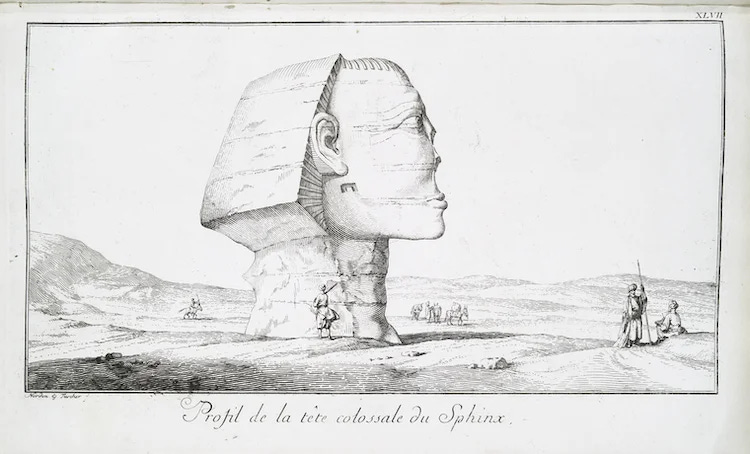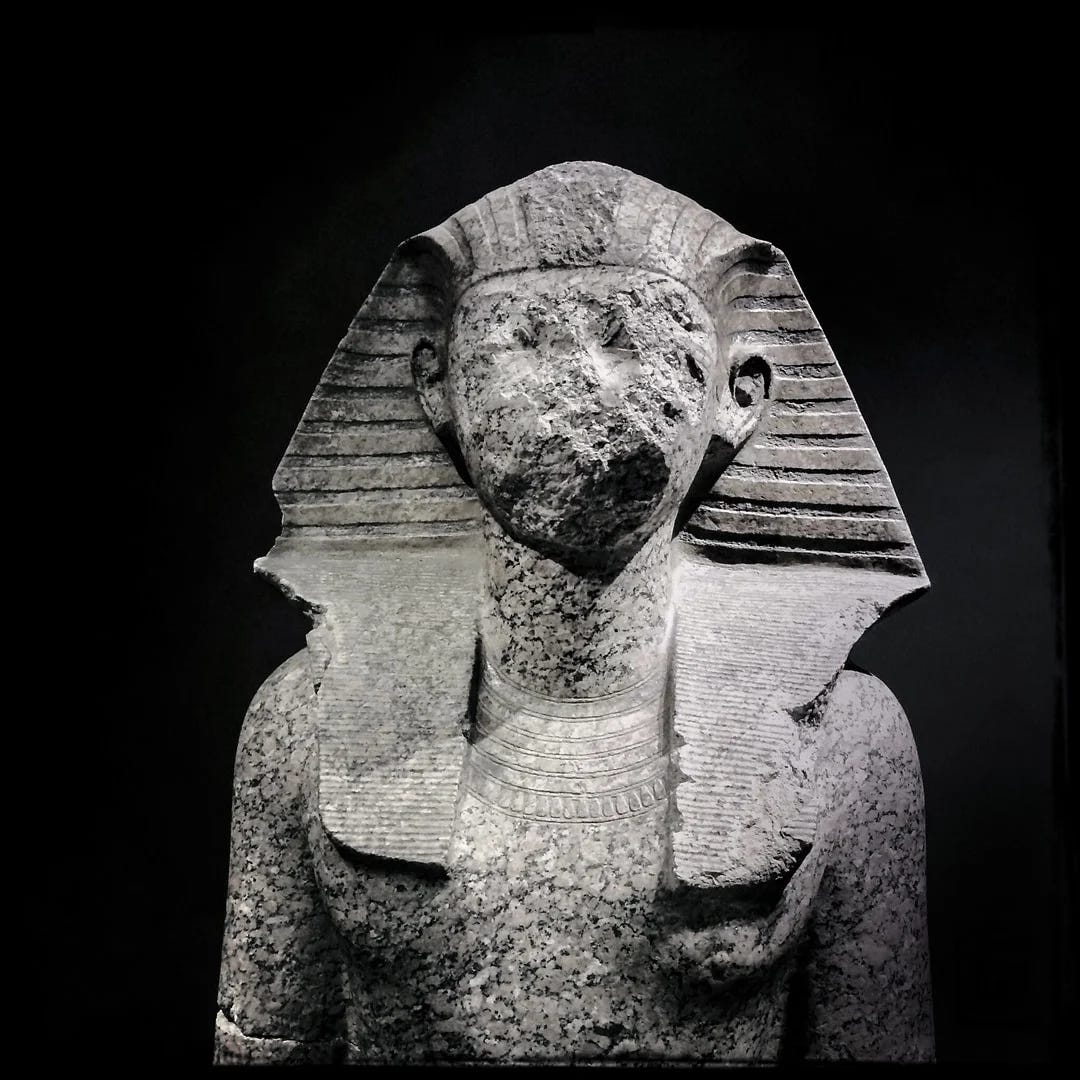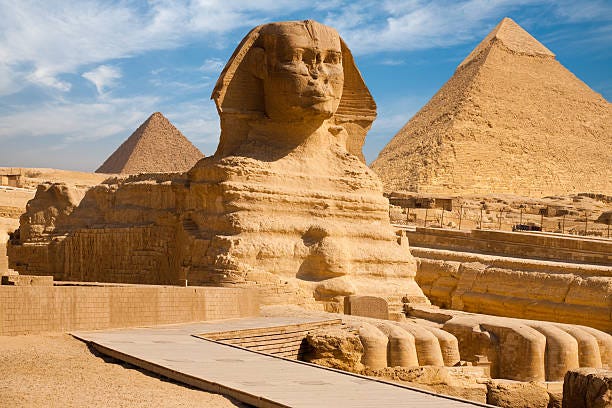Hey everyone,
The story behind this bonus episode is the wildest ride because it all started with one of my History in the News round-ups. On the 20th I wrote something about the mystery of how the Sphinx’s nose disappeared, which I then talked about on Instagram, which then went viral, garnering me 4,000 new followers in 48 hours (and also about that many hateful comments in my DMs). So Niko and I did a slightly deeper dive into what happened to the Sphinx’s nose, and here we are: A bonus episode dedicated to the myths surrounding the destruction of the Sphinx’s nose (it wasn’t Napoleon’s army!) and our best ideas as to what really happened to it.
To give free subscribers a taste of what our bonus episodes are normally like, I have made this episode free for everyone. If you want to upgrade to get more bonus content like this in the future (there’s a bunch coming in season three!) upgrade now. I’m currently giving 13% off to celebrate season 3—giving 3% off seemed silly. If you sign up for an annual, plan, that’s like getting 3 months free!
Season 3 is coming at your next week! Until then, enjoy this story about the Sphinx and the mystery of its missing nose.
Hey everyone,
Welcome to another bonus episode of Unruly Figures! I am making this episode free for everyone so you can see what these episodes are all about. If you like this type of shorter bonus content and you want more of it, become a paying subscriber on Substack! The link is in the show notes.
You’ve probably heard the story that Napoleon’s army shot off the nose of the Sphinx as target practice during his military campaign in Egypt in the late 1790s. This is the version I was given in school, even in my art history class, but as I found out a couple of weeks ago–it’s totally wrong. Decades before that campaign, when Napoleon Bonaparte wasn’t even a twinkle in his parents’ eyes yet, a Danish naval captain named Frederik Ludvig Norden traveled to Egypt and drew the Sphinx without her nose. He published these illustrations in his 1757 book, Travels in Egypt and Nubia. Interestingly, digitized versions of the French manuscript don’t seem to contain this image, but the digitized English versions do.

So, who did destroy the Sphinx’s nose, if not Napoleon?
One popular theory is that the nose was destroyed in the late 14th century by Sheikh Muhammad Sa'im al-Dahr, a devout Sufi from a convent of Dervishes. Arab historian al-Maqrizi, who lived in the 14th and 15th centuries and wrote 200 works mostly on Egyptian history, including his famous Description topographique et historique de l'Égypte. In that book he explained that local lore at the time said that the Sphinx protected Giza from the encroachment of sand from the Sahara. Apparently, some people even made offerings to the Sphinx’s head (which was all that they could see back then), but it’s not clear from al-Maqrizi’s account who is offering what. Anyway, so Sa’im al-Dahr, the devout Sufi who was traveling to combat superstitions in Egypt, in the year 1378 or 1379, maybe saw this local worship and decided to destroy the Sphinx’s nose somehow as part of his whole mission to spread Islam. How he did this is not made clear al-Maqrizi’s account but he does say that in the century since al-Dahr destroyed the Sphinx’s nose, Giza had been dealing with more encroachment of sand from the desert and the locals blamed al-Dahr for this. It seems like maybe his attack just made people believe in the Sphinx’s power to protect them more.
Side note, a lot of contemporary writers claim that the local Egyptians were making offerings to the Sphinx for the harvest or to control flooding, but that is not in al-Maqrizi’s account.
In the 2010 documentary Riddles of the Sphinx, famous Egyptologist and archaeologist Mark Lehner shares his theory that the nose was deliberately carved off using chisels or wedges. As you can see from this screenshot, he points to two deep grooves that might have been used to snap it off. Some sources say that this would have happened between 200 and 900 CE, but I didn’t see Lehner saying that anywhere, so it’s possible it happened later.
It’s worth noting that Lehner believes prying off the nose also damaged the upper lip of the Sphinx. He also mentioned in his PhD dissertation that there appears to be man-made damage to the eyes too, maybe picking with a hammer or something similar. To me, knowing that most of the face has been damaged on purpose, not just by weathering, suggests that it was motivated by iconoclasm, which is the destruction of art or images that are considered heretical or that someone wants to discredit for some reason. Obviously, it would have been hard work to pry off that nose, and wouldn’t have happened quickly, so someone must have been doing it to say something, but that message has been lost with time.
A lot of popular theories of the destruction of the Sphinx’s nose say that it was another pharaoh who did this to consolidate, and a lot of fans of Egyptian history claim that this was a common practice but this wasn’t usually the case. Later pharaohs did destroy the iconography of the female pharaoh Hatshepsut, but that was an isolated issue. That was about her, not a traditional way to transfer power to a new ruler, because the statues of rulers in ancient Egypt were sacred themselves. Statues of pharaohs were sites of worship because the statue itself could house a god, or be a conduit to the god. So Egyptians were generally pretty respectful of depictions of previous pharaohs. And since the Sphinx probably has a pharaoh’s face on it, though we aren’t sure whose face, we can guess that that respect probably extended to the Sphinx.

It was actually Christians who were more likely to destroy the iconography of the pharaohs. They had a, quote, “habit of vandalizing artwork due to an entrenched culture of iconoclasm. The deliberate destruction of artworks was a way of counteracting the cultural and political power of the image.” I think most people agree that the Sphinx’s nose was deliberately destroyed because of a culture of iconoclasm, but whether it was Christian missionaries or Sufi missionaries like Sa’im al-Dahr is still very up for debate.
Without the actual nose itself–or like, a signed confession–we’ll probably never really know for sure who pried this nose off and why. That said, more things are being uncovered around Giza every year, so maybe someday the nose will appear.
If you’re interested in learning more about the Sphinx, that Nova documentary that I mentioned earlier is a great starting place.
















Share this post